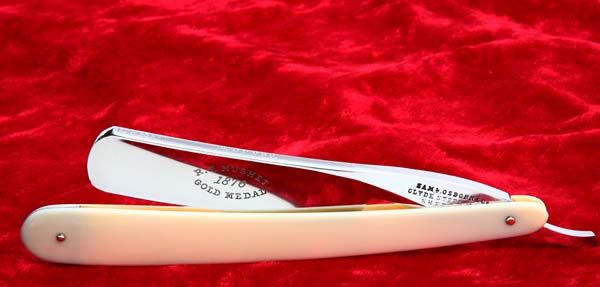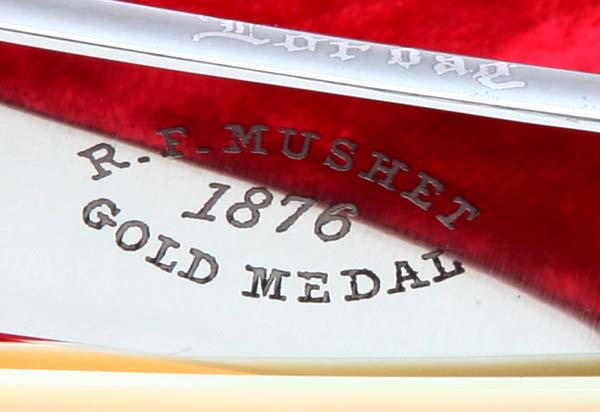Results 1 to 4 of 4
-
03-03-2015, 03:42 AM #1Junior Member

- Join Date
- Feb 2015
- Location
- philly
- Posts
- 17
Thanked: 1 Looking for information on Clyde steelworks razor
Looking for information on Clyde steelworks razor
I recently picked up a razor and would like some information on it if anyone has any. The tang is stamped with SAML OSBORN & CO CLYDE STEEL WORKS SCHEFFIELD. From what I have found, the company produced razors from the 1850s to just after WWI. The side of the blade is stamped with R.F. MUSHET 1876 GOLD MEDAL. This refers to the alloy of the steel that was given an industry award in 1876 I'm guessing that this blade is from some time later. The blade is a round point, half hollow ground. I believe the scales are plastic replacements, however I'm too new to this to know for sure. If anyone knows when this razor was made and possible has photos of original scales I would appreciate hearing from you.
Thanks

-
03-04-2015, 06:35 PM #2Senior Member



- Join Date
- Apr 2008
- Location
- Essex, UK
- Posts
- 3,816
Thanked: 3164
Your razor and the company that made it has an illustrious history. There was a company called Clark, Hall & Clark created in 1817. Somewhere between 1817 and 1822 Samuel Osborn (senior) enters the company, for it is mentioned as Clark & Osborne in 1822 Trade Directories. The partners were Marmaduke Clark and Samuel Osbourne. It lasted about 10 years with Marmaduke Clark died in 1832. Samuel Osborn had a son, also called Samuel who was born in Sheffield in 1826. This Samuel is our man!
At the age of 15 (1841 or thereabouts) Samuel joined a drapers firm, then went to work for Thos. Ellin & Son, toolmakers, then on to H. Russell & Son as a travelling salesman.
In 1851 he started out on his own account with the acquisition of the Clyde Works and in 1857 he set up the Brookhill Works, both in Sheffield. He was now a full-blooded steel maker. In 1867 he bought the Clyde Iron & Steel Works, based in Sheffield, forming a company with his brother in law, one William Fawcett.
In 1870 Osborne was introduced to Robert Forester Mushet, son of the great scottish iron master David Mushet. In 1845 Robert had taken over his fathers works at Darkhill, Forest of Dean. Mushet was as clever as his father, and in no time he had performed over 10,000 experiments in the Forest of Dean. If David was the Man of Iron, then Robert was the Man of Steel. However, he was self effacing, shy and more immersed in studies on steel than business arrangements. Henry Bessemer could not make his steel convertor work at first, so he consulted Robert Mushet, who got it to work by adding an impure alloy to it (Bessemer's ores were, strangely, too pure). Bessemer got accolades. awards, a seat on the body that governs the steel industry and medals for his cheap process of converting iron ore to steel in in his converter. Did he mention Robert Mushet? No - he kept the glory - and the money - for himself.
Osborn bought the sole title to the RMS manufacturing process, and Mushet visited his works to ensure that operations were up to his standards. He so trusted Osborn (who was elected to the cutlers company in 1862. He became noted as a very caring boss, looking after his workers welfare and health. In 1873 he was voted Master Cutler of the Cutlers Guild and in 1890, the year before he died he was so well thought of by all the community that he was elected Lord Mayor of Sheffield) that he left his two sons, Henry and Edward to supervise operations until Osborn's men were familiar with it.
In his latter years Robert became destitute - the Royal Society had not even granted him a pension. He would not help himself so his daughter harangued everybody until Bessemer grudgingly awarded him a small pension.
When he met Samuel Osborne in 1870, Robert's business was still operating. In fact he had recently discovered an alloy of steel which had many suprising qualities and which he named 'Robert Mushet's Special Steel' or RMS for short. It had a high amount of tungsten in it (8 per cent), was self hardening and was ideal for railroads, which Osborne used it for. Soon, RMS was to be found in the railroads of most continents - it was a super steel, indeed.
Mushet died in 1891 as did, curiously enough, Samuel Osborn. Osborn's company carried on working though.
I have had about ten of these myself, and I can say that in my experience, the edge is superior to many razors, giving a close but smooth shave. They all had ivory scales, except for three that had good, solid rounded-edge scales made fom dark cowhorn. Six of them were in a seven day set, an export to Sweden (Swedish people appreciate fine steel, they also imported many Cadman 'Bengall' razors) and these were frost acid etched in Swedish and all had ivory scales:


So, we can assume that your razor is no earlier than 1876 (the year the medal was awarded) and if no 'England' mark is on the tang it could be no later than 1890, as the McKinley Tariff Act was passed in the US requiring all goods to bear a country of origin, and this became widespread by 1891 or so.
You have a 14 year window, which is quite small in razor-dating terms!
Regards,
NeilLast edited by Neil Miller; 03-04-2015 at 09:30 PM. Reason: additional material
-
-
03-04-2015, 06:45 PM #3Junior Member

- Join Date
- Feb 2015
- Location
- philly
- Posts
- 17
Thanked: 1
Incredible. Thank you so much for the information!
-
03-04-2015, 06:48 PM #4Senior Member



- Join Date
- Apr 2008
- Location
- Essex, UK
- Posts
- 3,816
Thanked: 3164
You are welcome.
Regards,
Neil


 8Likes
8Likes
 LinkBack URL
LinkBack URL About LinkBacks
About LinkBacks






 Reply With Quote
Reply With Quote